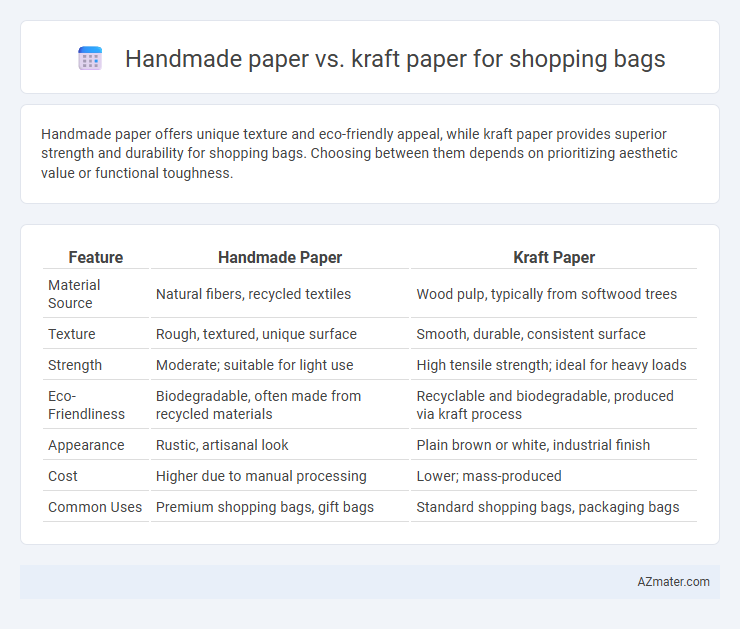Handmade paper offers unique texture and eco-friendly appeal, while kraft paper provides superior strength and durability for shopping bags. Choosing between them depends on prioritizing aesthetic value or functional toughness.
Table of Comparison
| Feature | Handmade Paper | Kraft Paper |
|---|---|---|
| Material Source | Natural fibers, recycled textiles | Wood pulp, typically from softwood trees |
| Texture | Rough, textured, unique surface | Smooth, durable, consistent surface |
| Strength | Moderate; suitable for light use | High tensile strength; ideal for heavy loads |
| Eco-Friendliness | Biodegradable, often made from recycled materials | Recyclable and biodegradable, produced via kraft process |
| Appearance | Rustic, artisanal look | Plain brown or white, industrial finish |
| Cost | Higher due to manual processing | Lower; mass-produced |
| Common Uses | Premium shopping bags, gift bags | Standard shopping bags, packaging bags |
Introduction: Handmade Paper vs Kraft Paper for Shopping Bags
Handmade paper offers a unique texture and eco-friendly appeal, made from natural fibers with minimal processing, making it ideal for artisanal shopping bags. Kraft paper, produced through kraft pulping, boasts superior strength and durability, commonly used for robust and recyclable shopping bags. Both materials provide sustainable options, but kraft paper is preferred for heavy-duty use while handmade paper suits niche, decorative packaging needs.
Material Composition and Sources
Handmade paper for shopping bags is primarily composed of natural fibers such as cotton, hemp, or recycled cotton rag, sourced from sustainable plantations or textile waste, offering a unique texture and eco-friendly appeal. Kraft paper is made from wood pulp through the kraft process, typically sourced from softwood trees, providing high strength and durability ideal for carrying heavier items. The material composition and sourcing significantly influence the environmental impact and functionality, with handmade paper emphasizing sustainability and aesthetic uniqueness, while kraft paper prioritizes robustness and cost-efficiency.
Manufacturing Process Comparison
Handmade paper is produced through a labor-intensive process involving manual pulping, sheet formation using traditional molds, and natural drying, which results in a unique texture with irregular fibers. Kraft paper manufacturing relies on a chemical pulping process where wood chips undergo kraft digesting to break down lignin, followed by mechanical pressing and drying for consistent strength and durability. The handmade process emphasizes artisanal quality and eco-friendliness, while kraft paper production prioritizes scalability, uniformity, and high tensile strength suitable for heavy-duty shopping bags.
Environmental Impact and Sustainability
Handmade paper for shopping bags offers superior biodegradability and uses fewer chemicals in production, reducing environmental pollution compared to kraft paper. Kraft paper, while strong and recyclable, typically involves a more intensive chemical pulping process that can contribute to deforestation and water pollution if not managed sustainably. Choosing handmade paper supports eco-friendly practices by promoting renewable resources and minimizing carbon footprint in the packaging industry.
Durability and Strength for Retail Use
Handmade paper offers unique textures and eco-friendly appeal but generally lacks the tensile strength and durability required for heavy-duty retail shopping bags. Kraft paper, produced from chemical pulp, is highly durable and resistant to tearing, making it ideal for carrying substantial weight and withstanding daily use. Its strong fiber composition ensures longevity, crucial for retail environments demanding reliable and sturdy shopping bags.
Aesthetic Appeal and Customization Options
Handmade paper shopping bags offer a unique, textured aesthetic appeal characterized by natural fibers and an artisanal finish, making each bag distinct and visually appealing for boutique or eco-friendly brands. Kraft paper bags present a more uniform and rustic look, with a smooth surface that is ideal for high-quality printed logos and vibrant custom designs, ensuring brand visibility and consistency. Customization options are broader with kraft paper due to its compatibility with various printing techniques such as flexography and screen printing, while handmade paper primarily supports limited, subtle embellishments like embossing or eco-friendly ink stamps.
Cost Analysis: Production and Retail Pricing
Handmade paper involves higher production costs due to labor-intensive processes and lower output efficiency, resulting in premium retail pricing for shopping bags. Kraft paper benefits from automated manufacturing and bulk raw material sourcing, significantly reducing production expenses and allowing competitive retail prices. Retailers must balance the artisanal value of handmade paper bags against the cost-effectiveness and durability of kraft paper for optimal pricing strategies.
Consumer Perception and Brand Image
Handmade paper shopping bags evoke a sense of artisanal quality and environmental consciousness, enhancing brand image through unique textures and eco-friendly appeal. Kraft paper bags are perceived as durable, cost-effective, and reliable, reinforcing a practical and straightforward brand identity. Consumer perception favors handmade paper for premium or niche markets, while kraft paper aligns with mass-market functionality and sustainability messages.
Functional Advantages and Limitations
Handmade paper offers a unique, eco-friendly texture that enhances brand appeal but has lower durability and moisture resistance compared to kraft paper, making it less ideal for heavy or wet items. Kraft paper provides superior strength, tear resistance, and better moisture protection, supporting heavier loads and improving bag longevity. However, kraft paper lacks the aesthetic uniqueness of handmade paper and may require additional treatments for premium branding.
Choosing the Right Paper for Shopping Bags
Handmade paper offers a unique texture and eco-friendly appeal, making it ideal for boutique shopping bags that prioritize sustainability and aesthetic value. Kraft paper is known for its durability, strength, and affordability, making it a practical choice for heavy-duty shopping bags requiring high tear resistance. Selecting the right paper depends on the balance between environmental impact, bag strength, and brand image preferences.

Infographic: Handmade paper vs Kraft paper for Shopping bag
 azmater.com
azmater.com